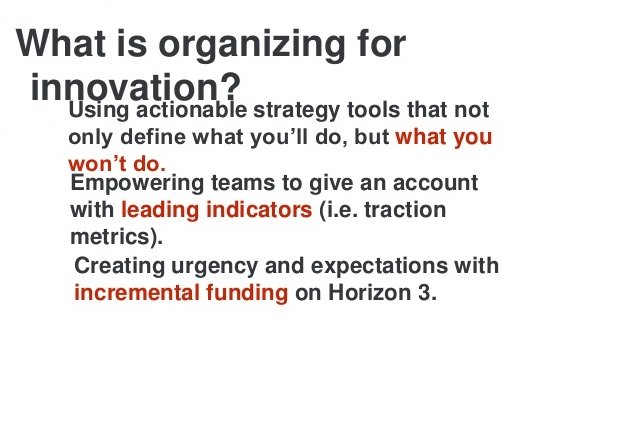The ten most innovative companies are ranked by their innovation premium. This is the difference between their market capitalization and a net present value of cash flow from existing businesses. The difference between them is the bonus given by equity investors on the educated hunch that the company will continue to come up with profitable new growth. By this measurement are shareholders involved.
A disruptive company is a business whose innovations force other businesses to alter their strategic course. They are changing the market.
Traditional technology can manage that, until a new technology is made. After some time, the disruptive innovation is able to easily meet the customer’s demand for performance.
Radical innovations replace existing products, technologies and markets.
Reasons for a company to do innovation:
- A successful new product does more good to an organization than anything else that can happen.
- Growth
- Companies need always innovations to stay alive.
Innovation product life cycle:
- Introduction
- Growth
- Maturity
- Decline
The new things are happening before the introduction stage. But although it is on the beginning of the life cycle, the company should already know what is going to happen in the next stages.
Innovation is the process from idea to product. Innovation is depending on creativity of individuals, firm’s operating functions and activities and firm’s architecture and external linkages.
There are push and pull innovations. Push innovations are based on the latest science and technology advances in society. Pull innovations are based on the needs in society and the marketplace.
Invention: creation of a unique, hopefully patentable, device/configuration/process. An invention is only an innovation if it is marketable.
Innovation: transforming an invention into a commercial product that can be sold profitably.
Innovation management: the management of all activities involved in the process of idea generations, technology development, manufacturing and marketing of a new product or manufacturing process or equipment.
Product development/product design product planning: the complete process of transforming an opportunity into a new product and introducing it successfully in the market.
Product design: industrial design (art, science and technology)
There are some spectrums of design activities: engineering, product/use, fashion/trends, engineering solutions, form concepts and design trends.
There are two main business processes:
- The process of repeatedly making a product/service and delivering that to the customer. It focuses on the buy-make-distribute-sell-service, the supply chain and on operational value stream.
- The process of designing a new product/service that is profitable in the market. It focuses on design, development, innovation chain and development value stream.
The operational value stream consists of activities that converting raw material to products in the hand of the customers and activities that are value creating because customers pay for the changed materials.
The operational value stream has the following characteristics: material flow, it is repeated and there is process control.
The development value stream consists of activities that create profitable operational value streams and activities that create useable knowledge, which involves learning.
The development value stream has the following characteristics: information flow, it is a one time stream and there is a disciplined process.
The state has different roles in innovation:
- Purchaser
- Financing R&D
- Educational and other societal effects
- Competition regulator
- Environment and safety regulator
- Infrastructure
- Macroeconomic conditions
- Information and decision center, create political stability
The industry attractiveness can be determined by Porters model, which identifies five factors: threat of new entrants, bargaining power of suppliers, bargaining power of buyers, rivalry among existing firms and the threat of substitute products and services.
Innovativeness can be measured on different levels. On national/regional level a scoreboard can be used. On industry level the innovation index is a way to measure innovativeness. At the firm level, the percentage of sales of new products, the value of patents or the Net Promotor Score.
The Net Promotor Score is a measurement, which is based on the question if a costumer would recommend this product/service/organization to a friend or colleague. The Net Promotor Score is calculated by the percentage promotes minus the percentage detractors.
Frugal innovation is an innovation strategy of a large market, which implies that private companies can make significant profits by selling to the poor. By selling to the poor, private companies can bring prosperity to the poor and thus can help eradicate poverty.
The diffusion of innovations is divided into five categories: the innovators, early adopters, early majority, late majority and the laggards.
Factors that are influencing adoption:
- Relative advantage: The degree to which an innovation is perceived as being better than its precursors
- Compatibility: The degree to which an innovation is perceived as being consistent with the existing values, needs, and past experiences of potential adopters.
- Complexity: The degree to which an innovation is perceived as being difficult to use.
- Observability: The degree to which the results of an innovation are observable to others.
- Trialability: The degree to which an innovation may be experimented with before adoption.

One thought on “Organizing for Innovation”